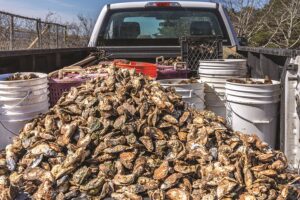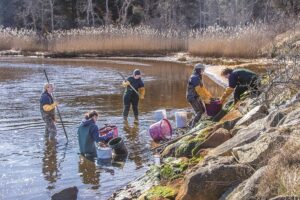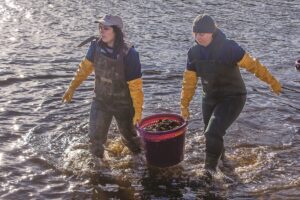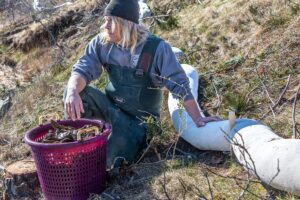WELLFLEET — Shellfish Constable Nancy Civetta, Assistant Constable Johnny “Clam” Mankevetch, and five AmeriCorps volunteers got to the Chequessett Neck Bridge just before low tide on the morning of April 8 for a rescue operation. They were saving oysters that had curiously determined to grow on the acidic and oxygen-parched upstream side of the Herring River dike.

Civetta and Mankevetch had been tipped off by local shellfisherman Michael Parlante, who noticed a reef of oysters growing above the dike. To add insult to injury, the reef was directly in the path of the encroaching construction of a temporary bypass bridge, part of the Herring River restoration now underway.
The seven pulled on their waders at 7 a.m., rolled up their sleeves, and started raking the oysters into baskets.
“If we don’t move these oysters, they’re going to be destroyed,” Civetta said before getting her hands into the mud and brine. The goal was to relay as many oysters as the team could from the landward side of the dike to the seaward side. By the time they finished, they had moved about 20,000 oysters.
These oysters, Civetta said, are not for harvest. That’s because that area of the river tests high for fecal coliform, a bacterium that impairs water quality and is likely the result of the area’s large bird population. Div. of Marine Fisheries (DMF) regulations prohibit shellfish harvesting there.
Although the oysters should grow well in their new location, where tidal flow is strong and they’ll be out of the way of bridge construction, shellfishing is also prohibited there. The 30 acres directly above the dike and 30 acres below it are both restricted, Civetta said.

These oysters are instead expected to serve as spawning stock — the parents of future generations. “When oysters release larvae, those larvae stay suspended in the water column for one to two weeks before they settle on the bottom,” Civetta said. “If they travel on an outgoing tide, they could settle somewhere else in the harbor that’s not a prohibited area, and they’ll be clean and harvestable.”
This is not the town’s first oyster relay mission. In 2021, Civetta’s department rescued thousands of oysters in Chipman’s Cove before the harbor dredging project churned up sediment harmful to shellfish.
Mankevetch called the organisms “fecund spawners” as he stood at the lip of the bridge with a clam rake in his hand. With the magic of fecundity on their side, thousands of larvae must have traveled through the dike with the incoming tide before settling onto the rocky surface of the bridge, he surmised.
Oysters, Mankevetch said, “are a fast-growing, fast-maturing, big-spawning species — they’re the bunny rabbits of shellfish.” Adult females can release five to eight million eggs at one time, though Mankevetch said only an infinitesimal percentage of larvae actually end up as three-inch market size oysters. He estimated that the oysters had been growing at the dike for up to five years. Because they are not harvestable they accumulated quickly.
Mankevetch noted that they showed some evidence of damage from acidification that afflicts the area behind the dike, where tidal flow has been restricted for so many years. Some shells were pocked with tiny holes.

After getting needed approvals from the DMF and restoration project managers on Wednesday, Civetta solicited extra hands from AmeriCorps Cape Cod. “We couldn’t have done it without them,” she said. “I am really impressed with these young people. These are some intrepid souls.”
The five young shellfish first responders shoveled oysters into buckets and hauled them up the steep incline onto the road. As they grew more comfortable with the work, they developed different techniques: volunteers Will Longo and Leo Lainez scooped brimming rake-fulls of oysters into the buckets. Avalon Hadley and Emma Grace Deily-Swearingen meticulously sorted them, making sure hollow shells or rocks didn’t make it into the bunch.
Halfway through the relay, Deily-Swearingen began to hum. “How many shellfish songs are there?” she asked.
“In Wellfleet?” Mankevetch said. “Over a hundred.”
Just then, an osprey swooped down from the cloudless sky and snatched a herring from the river a couple of hundred yards away. “That was awesome,” volunteer Jodi Monroe said.
From the top of the incline, Mankevetch tossed empty buckets back down to the water after emptying each of them of 40 pounds of oysters. Every time a bucket hit the water, Mankevetch threw his fist in the air and let out a yelp.
Civetta said she was grateful for Parlante’s tip about the reef. The rescue happened “thanks to a local shellfisherman,” she said.

“A great local fisherman,” Mankevetch said. “Make sure you get that in there.”
“Shellfishermen always have an eye for the environment,” Civetta said. “The most important thing is to listen to them.”
Around 10 a.m., three hours after the crew arrived, Mankevetch looked down at the water. “I’m happy,” he said. “We got way more than we thought we were going to get.” The AmeriCorps volunteers climbed out of the water, took off their waders, and threw their rakes into the back of the pickup.
The next step was to move the oysters onto a boat to dump them overboard at a spot where Mankevetch knew they would thrive. There were so many that the last leg of the mission would take two boat trips.
But before that, the volunteers drove off to make a celebratory donut run. Behind them, the morning sun limned the rising tide.



